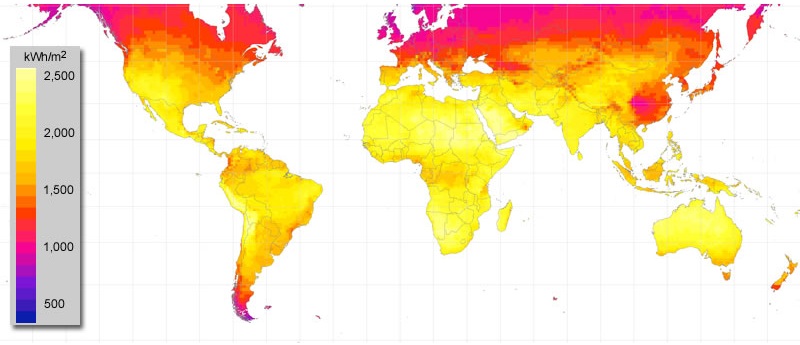Albedo
Bypass Diodes
Solar Glazing
Single Phase Versus Three Phase Power Supply
Three phase power supply
Single Phase Power Supply
Module Measurement without Load
Module Measurement with Load
[...]
 Yearly sum of global irradiance (source: GreenRhinoEnergy)Apart from this annual variation, there may be changes due to sun spot activity which happens every eleven and a half years approximately. Minor variations over much longer cycles e.g., 88 years, 208 years, and 1000 years have also been detected.The panel must be at right angles to the rays for receiving maximum energy. Any misalignment will reduce the intercepted power. This misalignment comes on a daily basis due to rotation of the earth, and an annual basis due to the inclination of the polar axis with the plane of the orbit.Ideally, a two axis solar tracker should be used. However, it is not cost-effective, nor very aesthetic in most situations, and fixed installations are preferred with panel slopes adjusted to achieve best results around the year. In some cases it may be possible to arrange for adjusting the panel slope once or twice in a year. Luckily, a misalignment of up to 15° will cause a loss of less than 10 percent.The azimuth orientation is normally kept south (in the northern hemisphere) but it may be useful to think about offsetting it by a few degrees depending on your daily load variation, the local demand curve and rate variations. Generally, usage will be more in the afternoon and evening than in the morning.Value it or not, the sun will shine till Doomsday.
Yearly sum of global irradiance (source: GreenRhinoEnergy)Apart from this annual variation, there may be changes due to sun spot activity which happens every eleven and a half years approximately. Minor variations over much longer cycles e.g., 88 years, 208 years, and 1000 years have also been detected.The panel must be at right angles to the rays for receiving maximum energy. Any misalignment will reduce the intercepted power. This misalignment comes on a daily basis due to rotation of the earth, and an annual basis due to the inclination of the polar axis with the plane of the orbit.Ideally, a two axis solar tracker should be used. However, it is not cost-effective, nor very aesthetic in most situations, and fixed installations are preferred with panel slopes adjusted to achieve best results around the year. In some cases it may be possible to arrange for adjusting the panel slope once or twice in a year. Luckily, a misalignment of up to 15° will cause a loss of less than 10 percent.The azimuth orientation is normally kept south (in the northern hemisphere) but it may be useful to think about offsetting it by a few degrees depending on your daily load variation, the local demand curve and rate variations. Generally, usage will be more in the afternoon and evening than in the morning.Value it or not, the sun will shine till Doomsday.